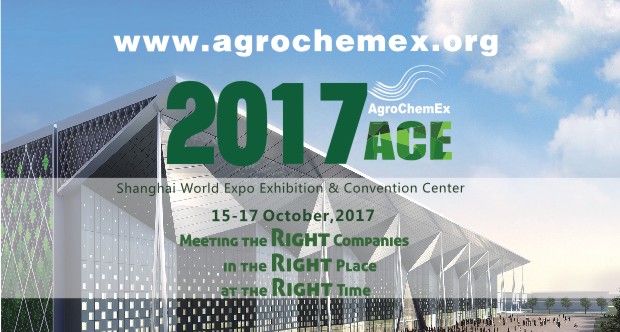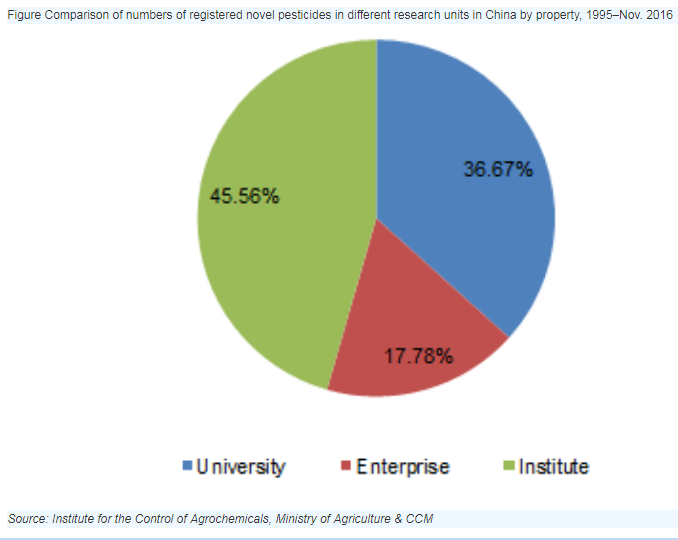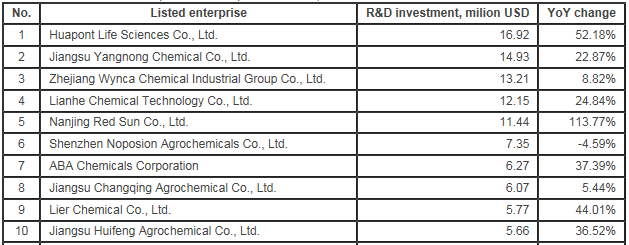AgroChemEx 2017: Giving an Overview of China's Agrochemicals Market
Publish time:9/30/2017 12:00:00 AM Source: CCM
Information collection and data processing: CCM For more information, please contact us
As the AgroChemEx, one of China’s largest exhibitions for the agrochemicals market is coming closer, market intelligence firm CCM is giving an overview of China’s agrochemical industry to prepare exhibitors and visitors alike for the discussions, negotiations and business talks ahead.

AgroChemEx
The AgroChemEx (ACE) in China is a yearly exhibition around the agrochemical industry, organized and carried out by the China Crop Protection Industry Association (CCPIA). With a rising number of attendees and exhibitors, the event gets more popular with industry players coming from countries like Thailand, India, Iran, Turkey, Russia, the USA, Australia, and Germany, among many others. After all, more than 600 exhibitors are expected to take part in the exhibition in 2017, which includes 80% of China’s pesticides producers.
Exhibitors are not only manufacturers in the pesticide formulations and technical industry, but also additives and intermediates producers, environmental protection and packaging equipment enterprises, consultancy companies, logistics service providers, and market analysis businesses.
The time of the exhibition is 15-17 October 2017. It will be held at the Shanghai World Expo Exhibition and Convention Center from 9:00-18:00 on all three days. The organiser is the China Crop Protection Industry Association.
CCPIA
CCPIA is one of the earliest professional industry associations in China, which was founded back in April 1982. Up to now, the organization has become the most renowned & authoritative agrochemical organization of China.
It is a non-profit organization registered as an independent legal entity under the Ministry of Civil Affairs in China. Furthermore, the association is one of the earliest industrial associations that have obtained approval from the former Ministry of Chemical Industry. Currently, the organization is supervised by Ministry of Information and Technology and Ministry of Civil Affairs, complying strictly with the law.
The CCPIA has focused on building connections between government sectors and pesticide manufacturers as well as among these manufacturers and promoting international cooperation. Currently, CCPIA has more than 600 corporate members, which are constituted from manufacturers, universities and institutes all around China, engaged in the R&D, or the production of pesticide TC and intermediates including adjuvants or only operation of pesticide, formulations and packaging, manufacturing of equipment. Together, they contribute over 85% of the whole domestic industry in terms of production volumes.
China’s agrochemical industry
With over 60 years of steady development, China has become the worldwide biggest production base of pesticides. China's pesticide output had kept an uptrend in 2010-2015, with a CAGR of 9.81%, reaching 3.74 million tonnes in 2015. Meanwhile, its output value grew at a CAGR of about 12.8%, hitting USD42.8 billion in 2015.
However, there are many problems in China's pesticide industry, such as overcapacity, inefficient production technologies, capital shortage, few well-known brands, and serious environmental pollution.
In 2016, China's total output of pesticide technical reached about 3.78 million tonnes, up by 0.99% compared with that in 2015. Hence, the market remained flat. Notably, in the years 2012 to 2016, it has been growing at an average year-on-year growth rate of 1.57%. Of the whole pesticide industry, the output of herbicides was accounted for 46.93% in 2016.
Chinese pesticide producers have been facing increasing production costs in China, which results from the increased environmental pressure by the government, conducting regular inspections.
China's import volume and value of pesticides decreased in 2016, reaching 84,000 tonnes and USD673 million respectively; while its export volume and value increased to 1.40 million tonnes and USD3,716 million, up by 19.23% and 4.79% year on year respectively.
China’s most important province in terms of pesticide production is Jiangsu Province, located north of Shanghai in the economically strong east region of China. This province is responsible for about 40% of the total pesticide output in China, producing 550,000 tonnes each year.
The government is modernising the agricultural production by limiting and banning the use of high-toxic pesticides to develop into an environmental friendly cultivation method. According to CCM, there are 39 pesticides that are completely banned for the use in China and more are restricted to only be used for dedicated crops. Notably, most of the banned pesticides in China are insecticides.
From the future period of 2017 to 2022, 34 active ingredients in the agrochemical market will come off their patent. Those 34 agrochemicals are divided into 15 herbicides, 7 insecticides, 11 fungicides, and one safener.
China’s domestic market as well as the international pesticides market furthermore are struggling with adversities, like sluggish demand, bans on an increasing number of pesticides, and a significant oversupply.
Investments in R&D
The number of new registrations can show market trends to some extent. 2,4-D, dicamba, glufosinate-ammonium, mesotrione and flumioxazin are herbicides registered the most in 2016; thiamethoxam and nitenpyram are insecticides with the most registrations; and pyraclostrobin, boscalid, trifloxystrobin and epoxiconazole were the most commonly registered fungicides in 2016.
It's worth noting that the number of new registrations obtained by foreign enterprises in 2016 was the same as that in 2015, while the number of new registrations obtained by domestic enterprises decreased sharply in 2016. What's more, among the 12 firstly registered pesticide technical, 8 were registered by multinational corporations and four were by domestic ones, which can be seen that foreign enterprises surpass domestic enterprises in the R&D of pesticide technical.
According to statistics from 86 pesticides with independent innovation from 1995 to November 2016, totally 37 research units are involved in the research of invention. Among these, in terms of the number of pesticides invented by research unit, Shenyang Research Institute of Chemical Industry ranked the first with 14 pesticides, followed by Zhejiang Research Institute of Chemical Industry Co., Ltd. (seven pesticides), and Central China Normal University and Nankai University (six pesticides respectively). While regarding the number of pesticides invented by an enterprise, Qingdao King Agroot Resistant Weeds Control Co., Ltd. took the first place with four pesticides, followed by Jiangsu Yangnong Chemical Co., Ltd. with three pesticides.
Comparison
of numbers of registered novel pesticides in different units by property,
1995-2016

Source: ICA, MOA, CCM
The R&D development is a crucial factor for China to meet the strict quality and safety requirements for food. It also supports a better reputation of Chinese manufacturers to ensure the acceptance in export markets. Both, the Chinese government as well as the domestic manufacturers are fully aware of the importance of innovative pesticide development and have increased their investment in the R&D segment significantly.
In H1 2017, the total R&D investment of the 20 main listed pesticide enterprises in China hit USD122.54 million, up by 33.26% year on year. Among them, two recorded year-on-year drops in their R&D investment. And the top three enterprises by R&D investment were Huapont Life Sciences Co., Ltd., Jiangsu Yangnong Chemical Co., Ltd. and Zhejiang Wynca Chemical Industrial Group Co., Ltd.
R&D
Investments of 10 listed pesticide enterprises in China, H1 2017

Source: CCM
China’s top pesticide manufacturers
China's pesticide production is mainly concentrated in East China including Jiangsu, Shandong, Henan and Zhejiang provinces, in terms of both the number of producers and tonnage, with the subtotal output contributing nearly 70% to the national total pesticide output. Thereinto, Shandong and Jiangsu provinces are the most important regions for China's pesticide production.
In China, the total number of pesticide producers was estimated to be over 4,000 as of 2015. The total fund for new product research of the whole pesticide industry in China is no more than USD0.07 billion annually, much less than that of even a single multinational player, such as Bayer CropScience, whose annual expenditure on innovation reaches about USD0.6 billion.
The total combined pesticide revenue of 2017 China top 100 pesticide enterprises reached USD16.55 billion in 2016, with a year-on-year decrease of 0.77%; while the total pesticide formulation revenue of 2017 China top 30 pesticide formulations enterprises was USD2.16 billion, down by 12.34% year on year.
The CCPIA, the organiser of the ACE, has published a list of the top 100 pesticide enterprises in China in terms of their pesticide revenue in 2016. As revealed by the statistics in the 2017 list, there was a large polarisation in the enterprises' pesticide revenues, caused by poor industry development, strict environmental regulations, policies on paraquat and mergers & acquisitions among enterprises. Thirty-nine enterprises achieved pesticide revenue of more than USD150.60 million in 2016, one enterprise less than last year. Besides, the total pesticide revenue of the top 10 enterprises reached USD4.82 billion in 2016, up by 3.97% year on year. The threshold of entering the 2017 list fell to USD46 million from USD51 million a year earlier, down by 11.20%.
The first and second rank on the list of the top 100 pesticide enterprises have both climbed 2 and 3 ranks, respectively, in comparison to 2016. Those two companies are Nutrichem and Shandong Weifang Rainbow. Nutrichem is also the only Chinese pesticide manufacturer with a pesticide revenue of more than USD685 in 2016. The third rank on the list is Fuhua Tongda Agro-chemical, a company based in China’s Sichuan province, which climbed from rank 20 in 2015 to the third rank in 2016 by increasing the revenue of pesticides from USD240 million to USD552 million. The first rank from 2015, Jiangsu Huifeng Agrochemical, fell to the fifth rank in 2016.
The largest pesticide formulation enterprise in China in 2017 is Shenzhen Noposion Agrochemicals, which is located in Guangdong province and stated a pesticide revenue of USD265 million in 2016, which is a decline from the year 2015. The company is ranked 19 on the list of China’s top 100 pesticide enterprises. Second and third ranked top pesticide formulation enterprises in China are Guangxi Tianyuan Biochemistry and Jiangsu Rotam Chemistry, respectively.
About CCM
CCM is the leading market intelligence provider for China’s agriculture, chemicals, food & ingredients and life science markets.
Do you want to find out more about the agrochemicals market in China? Try our Newsletters and Industrial Reports or join our professional online platform today and get insights in Reports, Newsletter, and Market Data at one place.